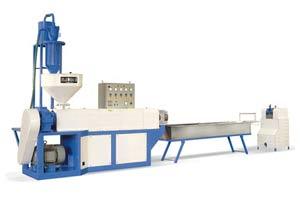
|
Ningbo Jinyi Precision Machinery Co., Ltd.
|
Gold Index: 25514
You are here: home > Study Room > Reasons for Extrusion Instability
Product (264)
-
Screw Barrel
(242)
- Single Screw Barrel (137)
- Injection Screw Barrel (29)
- Extrusion Screw Barrel (13)
- Bimetallic Screw Barrel (13)
- Twin Screw Barrel (18)
- Screw Barrel Accessory (21)
- Plastics Screw Barrel (8)
- Recycling Screw Barrel (2)
- Blowing Film Screw Barrel (1)
- Tie Bar (4)
- Reduction Gearbox (4)
- Auxiliary Machinery (14)
Trade Show (15)
Equipment (13)
Certificate (5)
Develop & Customers (1)
Study Room (17)
Credit Report
Products Index
Study Room
Reasons for Extrusion Instability

1) Instability of solid conveying
Three major factors are flow instability within hopper, modification of solid bed within screw and insufficient friction at barrel side.
1. Flow problems within hopper: Hopper Angle of Repose, Material quality (coefficient of friction), characteristics of particles and other factors are problems
* Angle of Repose : It represents hopper angle, and less than 35 degree of angle is good for smooth flow.
* Coefficient of friction : Coefficient of external friction (surface friction such as materials and hopper steel plate) and that of internal friction (frictions among particles). Generally, internal friction coefficient is five times bigger than that of external friction.
* Characteristics of particles : If possible, globular shape is better for smooth flow. In case of various materials are mixed, bigger specific gravity and smaller size allow faster flow, having possibility of seperated flow.
2. Flow problem within extruder
Solid conveying within screw is possible based upon the difference of friction between materials and barrel/ screw side. Adjusting temperature at the feeding section (heating or cooling) will have some impact.
2) Melting instability
There are three factors causing melting instability in the screw melting section.
1. Unstable solid conveyance
Due to unstable solid conveyance, the point that melting is originally completed is shifted, thereby causing pressure change and ultimately instability in compression section.
2. Destruction of solid bed
Due to destruction of solid bed, melt process becomes abnormal, and un-melted materials that are separated are mixed with melt in compression section, thereby bringing up the pressure of compression section. This is the most important reason for melting instability.
As melt at screw side easily causes the destruction of solid bed, adjustment of screw temperature or using barrier screw with double flight can prevent the problem.
3. Insufficient melt capacity
In case melt capacity is low, un-melted materials reach compression section, and in worst case un-melted portion remain in compressed materials. One way to confirm this is to heat the materials preliminarily, and less of un-melted materials reach compression section. If this happens, screw design should be reviewed once again.
3) Unstable conveyance of melts
1. It can happen due to design problems of metering section, and especially when screw is deep or metering zone is short. Problems arising from deep screw can be resolved when screw temperature is lowered. (When temperature is lowered for melts on the surface of screw, viscosity increases and this has the same impact from the case when screw depth is shallow, thereby resolving the problem of conveyance instability.)
2. Even for un-cooled screw, Maddock-type metering section can be installed to have the same impact with cooling screw.
If metering zone depth is minimized and length is extended, extrusion output will be diminished with more frictional exotherm.
4) Unstable venting process
1. Need for venting
Moisture in compound does damage to the exterior of fabricated materials and mechanical characteristics, and also brings down quality. The impact of moisture can be shown in two ways.
-Moisture will be vaporized at high temperature and the bubbles will adhere on the surface of fabricated materials.
-PC, PET and PBT will have reactions with moisture at high temperature (hydrolysis) and thermal degradation.
2. Vacuum Process
De-moisturizing process of compound through venting process is the discontinuous and diffusion process. Venting speed depends on the diffusion coefficient and the diffusion speed is dependent on temperature and concentration.
The venting temperature of solid polymer is limited at softening point, and the temperature range is about 70~120 degree. It takes a few hours for vacuuming at this temperature range, and vacuuming under melt status occurs at high temperature above 180 ~ 230 degree, happening at high speed.
5) Mixing instability
At metering section, mixing instability causes big changes in temperature and extrusion output in many cases. At the time when melting is completed, all materials show wide temperature range, causing un-homogeneity.
1. One component
-Mixing degree is enhanced when clearance at metering zone is small or long.
-Homogeneity of melts gets worse when screw RPM is higher and temperature range of melts is broader. Experiences show that if screw RPM becomes twice, length of screw feeding and compression sections should be longer by 50%. L/D (screw length/ screw diameter) at metering section is shorter when screw RPM is higher and miscibility gets lower. Under the normal processing conditions, solid bed destruction occurs and destructed portion can be mixed with melts, causing poor melt status and bringing down thermal conduction of resin. Ultimately, this also causes temperature change of melts together with extrusion output change. Most of the extrusion output changes are attributable to the destruction of solid bed.
-Mixing can be improved by increasing head pressure but it also causes decrease of extrusion output and more thermal degradation. This is not a good method.
2. Compounds including organic/ inorganic materials
-Large particles (particles larger than 10 ¥ìm) move freely without any interactions and depend on only the force of hydrodynamics.
-For small particles (particles smaller than 1.0 ¥ìm), there are difficulties in mixing due to interactions by static electricity, Vander waals and dipole force.
6) Instability of formation at die
1. Irregular die flow leads to extrusion instability, causing melt fracture, and shark skin at die lip. Accordingly, the die resistance is changed, causing the change of extrusion output.
2. As extrusion output gets higher, melt fracture and shark skin increase, and even under the same extrusion output more melt fracture and shark skin are found at low temperature.
3. All these problems occur when shear stress exceeds a certain limit on the surface of nozzle. The limit is changed depending on the resin itself and also affected by processing conditions, and space/ shape of die lip.
-Critical shear stress is 106 ~ 107 dyne/cm2 but as temperature goes up it gets higher.
-In case nozzle mouth is streamline shaped, it has large impact on critical shear speed.
-Critical shear speed gets high if nozzle L/D increases, together with increase of extrusion temperature.
-Critical shear stress is different from each and every resin and also different depending on each grade of same resin.
-Critical shear stress is affected by weight-average molecular weight but is not related to molecular weight distribution.
-Critical shear speed is high when molecular weight is small.
-For some resins, especially HDPE has super-fluidity range that no abnormalities occur to extrusion materials at normal critical shear speed or at higher speed.
7) Mixing with air
1. Mixing with air happens very often during extrusion, and it is attributable to the mixing with particles at hopper. If incoming air is not released, it affects exterior and properties of the product. Normally, the mixed air can be released at hopper, or if the air is sent to screw front part, die pressure will get higher causing explosive outburst of bubbles. If melt materials have bubbles, pressure change will occur.
2. The solution to this problem is to increase the temperature of the first barrel (C1) to accelerate the melting of solid bed (or in some cases the temperature has to be lowered). To speed up the completion of solid bed the head pressure can be enhanced. To bring up the head pressure, finer meshes can be used or replacement can be made with a thin mesh. Another solution is to change the particle size and shape, to use vacuum hopper, and to use vent-type extrusion machine.
3. In addition to the mixing of air from the bubbles of compression materials, more attention has to be paid to humidity, additives or volatile components out of the compound and thermal degradation. In some cases, pellet itself has small bubbles and the only solution to this problem is using vent-type extruder.
8) Decrease of extrusion output
1. In extrusion molding, decrease of extrusion output can happen when mesh is clogged or material feeding at hopper is not smooth. The problem related to the feeding at hopper can be the glitches of the material itself or by the situation such as insufficient cooling at hopper mouth and bridge problem from condensation.
Pre Page:
Extrusion Instability
Next Page:
Measures of Correcting Extrusion...



